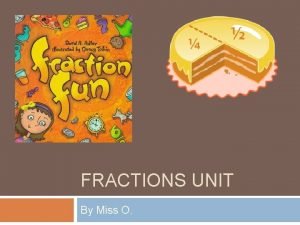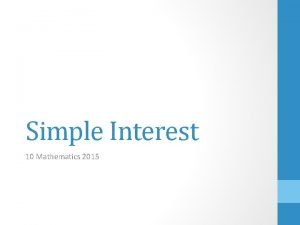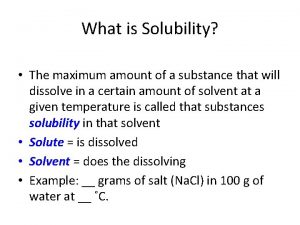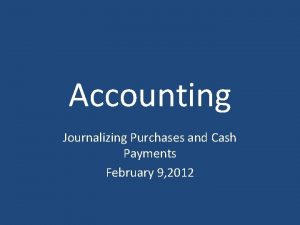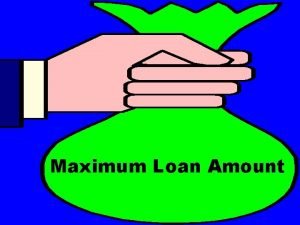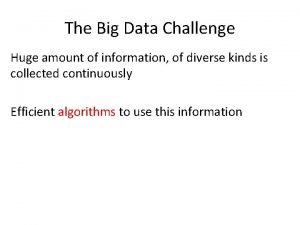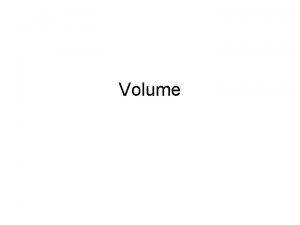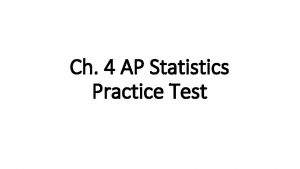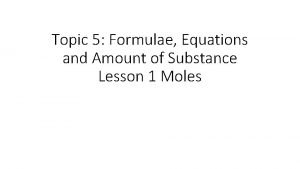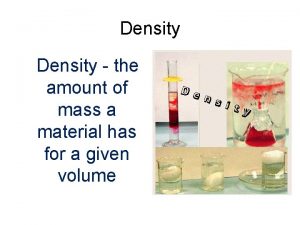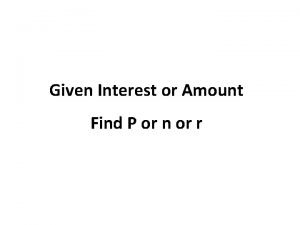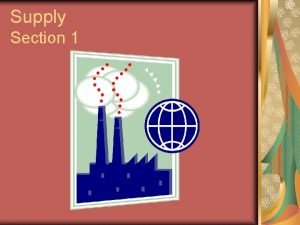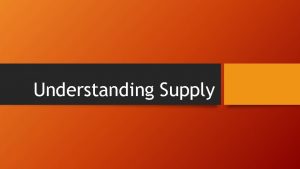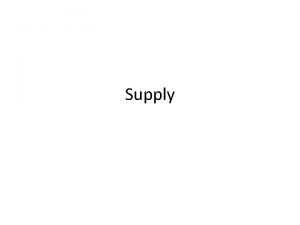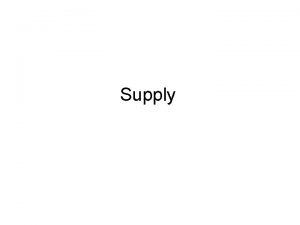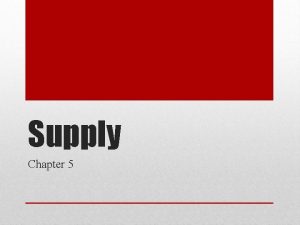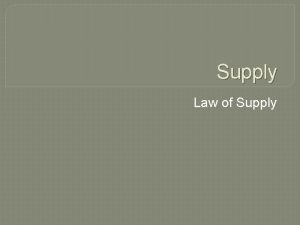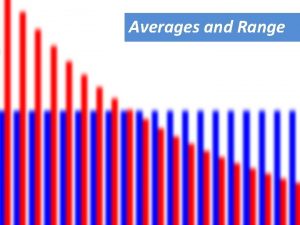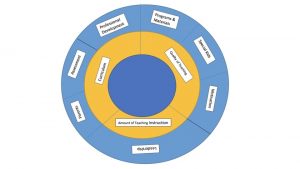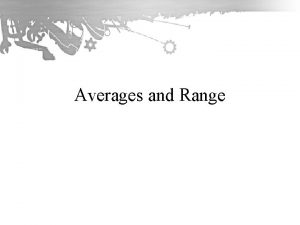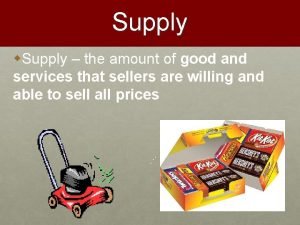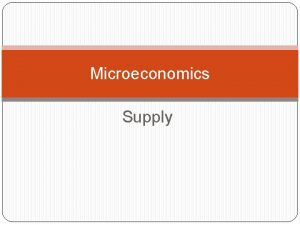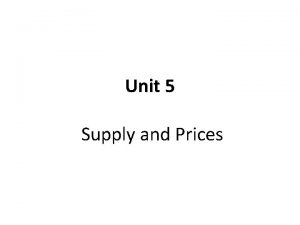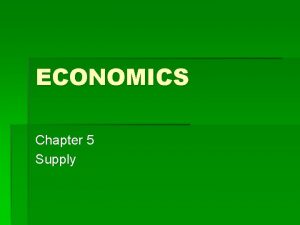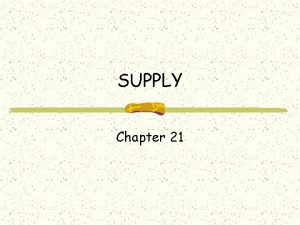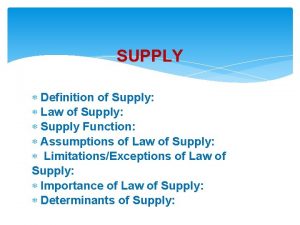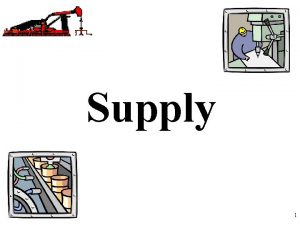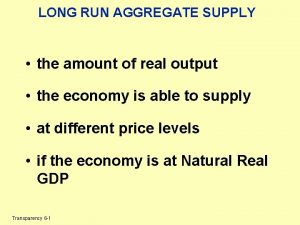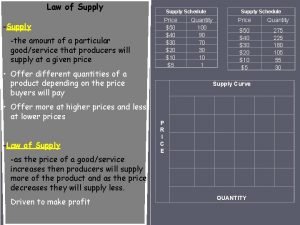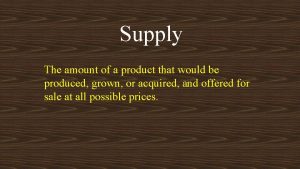What is supply l Supply is the amount





























































- Slides: 61

What is supply? l Supply is the amount of a product that producers are willing and able to offer for sale at all prices l To analyze supply, we use a… l l Supply Schedule – a table that lists the quantities supplied at different prices in a market Supply Curve – a graph of the supply schedule

Supply Schedule for Painting Services

Supply Curve for Painting Services $200 180 Price per Room 160 140 120 100 80 60 40 20 0 1 2 3 Rooms Painted per Week 4 5

Law of Supply l Law says l If prices are high = quantity supplied increases l If prices are low = quantity supplied decreases l Price and quantity supplied have a direct relationship l Quantity Supplied l amount of a good or service that producers are willing and able to offer for sale at a specific price

What can cause supply to change? l Week 1: I try to sell 10 pretzels at $0. 75. l Week 2: I try to sell 20 pretzels at $1. 00 each. l The PRICE increase of pretzels caused my supply to change. l This is called a CHANGE IN QUANTITY SUPPLIED!

Change in Quantity Supplied $200 l Shown by movement along the supply curve l PRICE changes always cause changes in Qs!! 180 Price per Room 160 140 B 120 100 A 80 60 40 20 0 1 2 3 Rooms Painted per Week 4 5

What can cause supply to change? l Week 1: I try to sell 10 pretzels at $0. 75. l Week 2: I try to sell 30 pretzels at $0. 75. l This time PRICE did NOT change. l Task! Provide a reason for my supply change. l Any of these reasons cause a CHANGE IN SUPPLY (not the Qs at one specific price). In this case the Qs at all prices will change!

Increase in Supply Price S 1 Quantity Supplied

Increase in Supply – Curve Shift to the Right Price S 1 Quantity Supplied S 2

Decrease in Supply Price S 1 Quantity Supplied

Decrease in Supply – Curve Shift to the Left Price S 1 Quantity Supplied S 1

Supply Shifters l Number of Producers/Sellers l l Cost of Inputs l l l Input costs refer to costs of production Increasing or decreasing costs will impact supply Productivity l The more productive workers are or the more efficiently businesses use resources then supply increases! l Technology l l When more businesses enter the market = supply increases or vice -versa New technology usually shifts curve to the right Natural Disasters or International Events l l Hurricanes, floods, wildfires decrease supply Wars and revolutions can have similar effects

Supply shifters continued… l Government Policy l Increased regulations restrict supply l Relaxed regulations increase supply l l Tax on the manufacture or sale of a good = decreases supply Subsidy (cash payment to producers) = increases supply • Producer Expectations • Anticipation of future events can affect supply curve • 1. Producers think prices will go up = decrease supply NOW • 2. Producers think prices will go down = increase supply NOW

Reminders l PRICE is NOT a supply shifter. When price changes, there is movement along the curve. l A change in supply, caused by factors other than the price of a particular good, is when the curve shifts. l l Shift to right = increase in supply Shift to left = decrease in supply

l The federal government begins offering large subsidies on the development and production of alternative fuel vehicles. What will this do to the market for alternative fuel vehicles?

l The federal government lifts its ban on animal cloning. Scientists develop a super-cow. This new breed of cow is four times larger than a regular cow. What will this do to the market for cow manure?

l Ten additional hair salons open in Doylestown Borough. What will this do to the market for hair extensions and hair cuts in Doylestown Borough?

l Leather sofa workers are now allowed to sit in their finished couches during breaks, lunch, etc. Because they are so well rested, workers can produce double the couches in the same amount of work time. What will this do to the market for leather couches?

Elasticity of Supply l Supply elasticity measures the sensitivity of producers to a change in price l l Small increase in price leads to large change in quantity supplied = elastic Small increase in price leads to little change in quantity supplied = inelastic

Supply & Demand Interaction l In a perfectly competitive market, supply & demand work together to determine prices. l The interaction usually creates 3 scenarios: l l l Equilibrium Shortage Surplus

Market Equilibrium l Equilibrium – point at which quantity supplied = quantity demanded l l IN OTHER WORDS: Qd = Qs Price in equilibrium is the equilibrium price and the quantity in equilibrium is the equilibrium quantity

Market Equilibrium l Price equilibrium can be found where the supply curve intersects the demand curve

Market Equilibrium Price 0 Quantity

Market Equilibrium Price S D 0 Quantity

Market Equilibrium Price S A P 1 D 0 Q 1 Quantity

Market Equilibrium Price S A P 1 Equilibrium D 0 Q 1 Quantity

Market Equilibrium Price S Equilibriu m Price A P 1 Equilibrium D 0 Q 1 Quantity

Market Equilibrium Price The equilibrium price is also known as the “market-clearing” price. At this price, both consumers and producers are satisfied. S Equilibriu m Price A P 1 Equilibrium Equilibriu m Quantity 0 Q 1 D Quantity

Equilibrium Changes l If demand increases… l l P _______ & Q _______ If demand decreases… l P _______ & Q _______

An Increase in Demand Price S 1 A P 1 D 1 0 Q 1 Quantity

An Increase in Demand Price S 1 A (Original Market Equilibrium) P 1 D 1 0 Q 1 D 2 Quantity

An Increase in Demand S 1 Price B A P 1 D 1 0 Q 1 D 2 Quantity

An Increase in Demand Price S 1 B P 2 A P 1 D 1 0 Q 1 Q 2 D 2 Quantity

An Increase in Demand Price S 1 B(New Market Equilibrium) P 2 A P 1 D 1 0 Q 1 Q 2 D 2 Quantity

Equilibrium Changes l If supply increases… l l P _______ & Q _______ If supply decreases… l P _______ & Q _______

An Increase in Supply Price S 1 A (original market equilibrium) P 1 D 1 0 Q 1 Quantity

An Increase in Supply Price S 1 S 2 A P 1 D 1 0 Q 1 Quantity

An Increase in Supply Price S 1 S 2 A P 1 P 2 B (New Market Equilibrium) D 1 0 Q 1 Q 2 Quantity

What happens when the price isn’t “right”? l When prices are set above or below the equilibrium price, disequilibrium occurs and results in… l l shortages surpluses

Shortage l Shortage – is a situation in which the quantity demanded is greater than the quantity supplied at a given price l l IN OTHER WORDS: Qd > Qs Shortage can also be called “Excess Demand” l When price is below the equilibrium price, there is a shortage and the price tends to rise towards equilibrium

Excess Demand Price S Equilibrium Price P 1 D 0 Quantity

Excess Demand Price S A Equilibrium Price P 1 Price below P 0 Equilibrium Price Equilibrium D 0 Quantity

Excess Demand Price S A Equilibrium Price P 1 Price below P 0 Equilibrium Price Equilibrium D 0 Qs 0 Quantity

Excess Demand Price S A Equilibrium Price P 1 Equilibrium Price below P 0 Equilibrium Price D 0 Qs 0 Q d 0 Quantity

Surplus explained by Michael Scott

Surplus l Surplus– is a situation in which the quantity supplied is greater than the quantity demanded at a given price l IN OTHER WORDS: Qd < Qs l Surplus can also be called “Excess Supply” l When price is above the equilibrium price, there is a surplus and the price tends to fall towards equilibrium

Excess Supply Price S Equilibrium Price P 1 D 0 Quantity

Excess Supply Price S Price above Equilibrium Price P 2 Equilibrium Price P 1 D 0 Quantity

Excess Supply Price S Price above Equilibrium Price P 2 Equilibrium Price P 1 D 0 Q d 2 Quantity

Excess Supply Price S Price above Equilibrium Price P 2 Equilibrium Price P 1 D 0 Q d 2 Qs 2 Quantity

What Roles Do Prices Play in a Modern Mixed Economy? l Purpose l Prices help consumers understand the costs of their decisions and help producers make production decisions. l Prices provide an incentive for firms and workers to produce. l Prices give markets flexibility to respond to changing conditions. l Prices guide scarce resources to their most efficient uses.

Prices l Up until now, we have assumed that the market is competitive and that prices, along with quantities offered for sale, are allowed to fluctuate l Is this a good thing? Why? l Would there ever be a time when prices would need to be controlled? Why?

l Price Controls l Governments implement price controls when prices are considered unfairly high for consumers or unfairly low for producers Price Floor – minimum legal price l l Prevents prices from going too low Usually results in an excess of supply = surplus Ex: Minimum Wage Price Ceiling – maximum legal price l l l Prevents prices from going too high Usually results in an excess of demand = shortage Ex. Rent Control

Price Ceiling = Shortage Price S A Equilibrium Price P 1 Price Below Equilibrium Price (Price Ceiling) Equilibrium P 0 D 0 Quantity

Price Ceiling = Shortage Price S A Equilibrium Price P 1 Price below P 0 Equilibrium Price Equilibrium D 0 Qs 0 Quantity

Price Ceiling = Shortage Price S A Equilibrium Price P 1 Equilibrium Price below P 0 Equilibrium Price D 0 Qs 0 Q d 0 Quantity

Price Floor = Surplus Price S Price Above Equilibrium Price P 2 (Price Floor) Equilibrium Price P 1 D 0 Quantity

Price Floor = Surplus Price S Price above Equilibrium Price P 2 Equilibrium Price P 1 D 0 Q d 2 Quantity

Price Floor = Surplus Price S Price above Equilibrium Price P 2 Equilibrium Price P 1 D 0 Q d 2 Qs 2 Quantity

Government Intervention Cause To achieve social goals, the government fixes prices. Effect Prices cannot adjust to their equilibrium levels.

Analyzing How Events Impact Markets l 1. Does this event change the price of the good or service that is in question? l If so, it is a change in Qd or Qs (movement along curve). l The factor is always PRICE. l 2. Does the event affect demand or supply? l Look for key words in the scenario to point you in the right direction. l 3. Does the event shift the selected curve to the right (increase) or to the left (decrease)? l 4. Which factor/shifter caused the change to the market. l 5. How have equilibrium price and quantity changed?
 Hươu thường đẻ mỗi lứa mấy con
Hươu thường đẻ mỗi lứa mấy con Thế nào là hệ số cao nhất
Thế nào là hệ số cao nhất Diễn thế sinh thái là
Diễn thế sinh thái là đại từ thay thế
đại từ thay thế Frameset trong html5
Frameset trong html5 Vẽ hình chiếu vuông góc của vật thể sau
Vẽ hình chiếu vuông góc của vật thể sau Thế nào là mạng điện lắp đặt kiểu nổi
Thế nào là mạng điện lắp đặt kiểu nổi Mật thư tọa độ 5x5
Mật thư tọa độ 5x5 Lời thề hippocrates
Lời thề hippocrates Vẽ hình chiếu đứng bằng cạnh của vật thể
Vẽ hình chiếu đứng bằng cạnh của vật thể Tư thế worm breton là gì
Tư thế worm breton là gì Quá trình desamine hóa có thể tạo ra
Quá trình desamine hóa có thể tạo ra Sự nuôi và dạy con của hươu
Sự nuôi và dạy con của hươu Các châu lục và đại dương trên thế giới
Các châu lục và đại dương trên thế giới Các loại đột biến cấu trúc nhiễm sắc thể
Các loại đột biến cấu trúc nhiễm sắc thể điện thế nghỉ
điện thế nghỉ Bổ thể
Bổ thể Thế nào là sự mỏi cơ
Thế nào là sự mỏi cơ 101012 bằng
101012 bằng Thiếu nhi thế giới liên hoan
Thiếu nhi thế giới liên hoan Vẽ hình chiếu vuông góc của vật thể sau
Vẽ hình chiếu vuông góc của vật thể sau Chúa yêu trần thế
Chúa yêu trần thế Một số thể thơ truyền thống
Một số thể thơ truyền thống Hệ hô hấp
Hệ hô hấp Cong thức tính động năng
Cong thức tính động năng Số nguyên tố là số gì
Số nguyên tố là số gì Tư thế ngồi viết
Tư thế ngồi viết đặc điểm cơ thể của người tối cổ
đặc điểm cơ thể của người tối cổ Tỉ lệ cơ thể trẻ em
Tỉ lệ cơ thể trẻ em Các châu lục và đại dương trên thế giới
Các châu lục và đại dương trên thế giới độ dài liên kết
độ dài liên kết ưu thế lai là gì
ưu thế lai là gì Thẻ vin
Thẻ vin Các môn thể thao bắt đầu bằng tiếng đua
Các môn thể thao bắt đầu bằng tiếng đua Cái miệng xinh xinh thế chỉ nói điều hay thôi
Cái miệng xinh xinh thế chỉ nói điều hay thôi Hát kết hợp bộ gõ cơ thể
Hát kết hợp bộ gõ cơ thể Từ ngữ thể hiện lòng nhân hậu
Từ ngữ thể hiện lòng nhân hậu Trời xanh đây là của chúng ta thể thơ
Trời xanh đây là của chúng ta thể thơ Tư thế ngồi viết
Tư thế ngồi viết Ví dụ về giọng cùng tên
Ví dụ về giọng cùng tên Voi kéo gỗ như thế nào
Voi kéo gỗ như thế nào Thơ thất ngôn tứ tuyệt đường luật
Thơ thất ngôn tứ tuyệt đường luật Matching supply with demand
Matching supply with demand Chapter 5 section 1 supply and the law of supply
Chapter 5 section 1 supply and the law of supply Elastisidad ng supply
Elastisidad ng supply Fractions of amount
Fractions of amount Rate formula in simple interest
Rate formula in simple interest Principle of counting
Principle of counting Solubility is the maximum amount of
Solubility is the maximum amount of 75 centavos in symbol
75 centavos in symbol Formula amount by age
Formula amount by age Special amount column definition
Special amount column definition This veterans basic entitlement is $36 000*
This veterans basic entitlement is $36 000* A huge amount of information
A huge amount of information The amount of space an object takes up
The amount of space an object takes up Tonya wanted to estimate the average amount
Tonya wanted to estimate the average amount Suspense amount
Suspense amount Chapter 3 journalizing transactions
Chapter 3 journalizing transactions Amount of substance equations
Amount of substance equations Density water
Density water The total amount of an employee's earnings is called
The total amount of an employee's earnings is called Sathya deposited rs 6000
Sathya deposited rs 6000













































